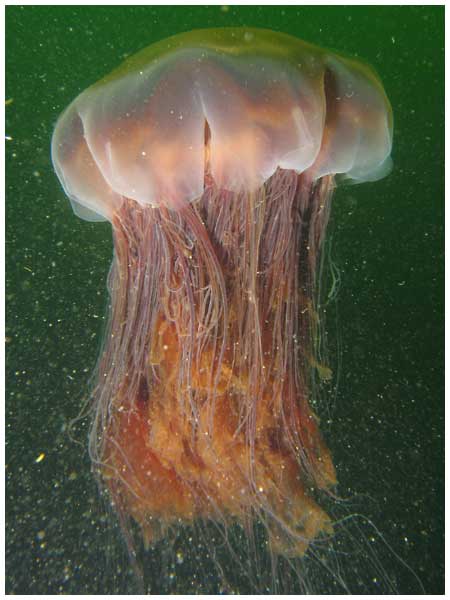Lion's Mane Jellyfish
From marinelife1011
Lion's Mane Jellyfish
| Glaucous Winged Gull | |
|---|---|
| Scientific classification | |
| Kingdom: | Animalia |
| Phylum: | Cnidaria |
| Class: | Scyphozoa |
| Order: | Semaeostomeae |
| Family: | Cyaniidae |
| Genus: | Cyanea |
| Species: | C. capillata |
| Binomial name | |
| Cyanea capillata Linnaeus, 1758 |
|
| Synonyms | |
|
Winter Jellyfish |
|
Description
The Lion's Mane Jellyfish, or Cyanea capillata is one of the largest jellyfish in the world, with a bell measuring up to 2 meters in diameter and tentacles trailing up to 30 meters. Most Lion's Mane do not reach this size, but the ones found in the arctic ocean and the upper north pacific can. Most Lion's Mane Jellyfish sighted on the Pacific or Atlantic coast are smaller, having a bell between 30cm and 50cm in diameter and have tentacles trailing 1 meter to 3 meters. The largest Lion's Mane, found washed ashore in Massachusetts Bay had a bell 2.3 meters in diameter and tentacles 36.5 meters long.
The bell or umbrella is divided into eight lobes, which give the Lion's Mane its flower or star shape. Each lobe has a cluster of tentacles, with between 70 and 150 tentacles each. These tentacles are hollow and possess nematocysts capable of causing painful stings. The Lion's Mane also has oral tentacles folded beneath the bell, attached to the maubrium, or the underside of its bell. The are generally as long as the bell is wide.
The coloration of a Lion's Mane Jellyfish ranges from deep red to reddish purple. Younger, smaller ones are generally yellowish brown or orange in color.
Behavior The Lion's Mane Jellyfish behaves just like any other jellyfish, being large plankton, as they are incapable of truly controlling where they move. Lion's Mane generally stay near to the surface and tend to stay in smacks. They feed mostly on plankton, moon jellyfish, small fish and ctenophores and are eaten by sea turtles, larger fish, and some seabirds. While in the open ocean, a Lion's Mane acts as a sort of sanctuary for certain smaller animals, which use it as cover or hide within its tentacles. These include certain species of shrimp, medusafish, and juvenile prowfish, which also feed on the Lion's Mane.
Habitat
Cyanea capillata is a coldwater jellyfish, and ranges from the North Pacific to the Arctic Ocean. They are also occasionally seen in the North Atlantic. They are primarily pelagic jellyfish, and thus remain out in open waters most of their lives. During summer, they come closer to shore, where most sightings occur. In the Pacific, the largest of the Lion's Mane can be found in the North Pacific near Alaska. Smaller Lion's Mane are quite common all throughout the North Pacific, along the British Columbia coast down to Washington. There are even occasional sightings of Lion's Mane Jellyfish in the waters off California. The largest of the Lion's Mane, however, are found mostly in the Arctic Ocean, where their food is more bountiful, and they can thus grow to immense sizes.
Reproduction
Lion's Mane Jellyfish reproduce like any other jellyfish, through sexual reproduction. Males release their sperm through their mouth, which are caught by females, beginning fertilization. This occurs in pouches along the oral arms. After fertilization, the planulae (small swimming larvae) leave the brood pouches, entering the water column. These eventually plant themselves on the sea floor, before transforming into polyps, which feed on plankton. These polyps multiply through budding, where pieces of them come off and become new polyps. The polyp is an entirely different stage of life for the Cyanea capillata and eventually grow into scyphistoma, or fully grown flowering polyps. When conditions are favorable, the scyphistoma transform into strobila, which are actually stacks of ephyra, which are the actual jellyfish. These simply break off of the strobila and enter the water column, where they grow into adult jellfish quickly.
Human Contact
The sting of a Lion's Mane Jellyfish is painful but not generally fatal, and is administered through nematocysts. Upon being stung, the affected develops a rash and burns profusely. This will cease after several hours, and will be replaced by a minor itch and localized redness, which will subsist after several days. Lion's Mane are capable of stinging even after death, and tentacles that have broken off are still capable of stinging for several hours.
REFERENCES
http://jellieszone.com/cyanae.htm
http://www.marlin.ac.uk/speciesinformation.php?speciesID=3109

